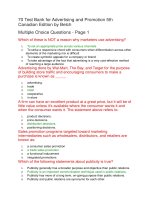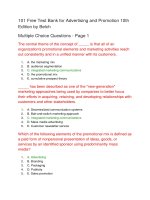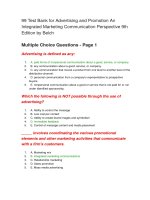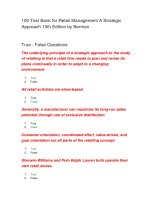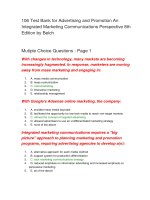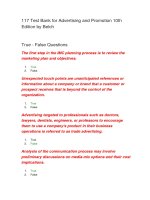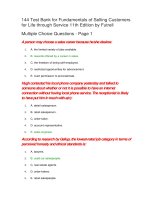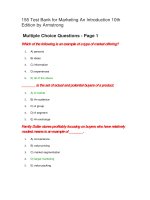117 test bank for advertising and promotion 10th edition by belch đề trắc nghiệm marketing
Bạn đang xem bản rút gọn của tài liệu. Xem và tải ngay bản đầy đủ của tài liệu tại đây (173.17 KB, 36 trang )
117 Test Bank for Advertising and Promotion 10th
Edition by Belch
True - False Questions
The first step in the IMC planning process is to review the marketing plan
and objectives.
1.
True
2.
False
Unexpected touch points are unanticipated references or information
about a company or brand that a customer or prospect receives that is
beyond the control of the organization.
1.
True
2.
False
Advertising targeted to professionals such as doctors, lawyers, dentists,
engineers, or professors to encourage them to use a company's product
in their business operations is referred to as trade advertising.
1.
True
2.
False
Analysis of the communication process may involve preliminary
discussions on media-mix options and their cost implications.
1.
True
2.
False
As marketers embraced the concept of integrated marketing
communications, they began to rely primarily on media advertising.
1.
True
2.
False
Nontraditional media account for the majority of companies' marketing
communications expenditures.
1.
True
2.
False
Business-to-business advertising is limited to industrial goods; services
such as insurance and travel service are not included in this category.
1.
True
2.
False
There has been an evolution to micromarketing as the mass audience
assembled by network television and augmented by other mass media is
fragmenting at an accelerating rate.
1.
True
2.
False
Primary-demand advertising focuses on creating demand for a specific
company's brands.
1.
True
2.
False
Most consumers in generation Y are very receptive to traditional
advertising.
1.
True
2.
False
The integrated marketing communications (IMC) approach to marketing
communications planning and strategy is popular among business-tobusiness marketers.
1.
True
2.
False
Companies or brands that are new to the market or those for whom
perceptions are negative should focus on the benefits or attributes of the
specific product or service, and not on their image.
1.
True
2.
False
The integrated marketing communications approach calls for a centralized
messaging function so that everything a company says and does
communicates a common theme and positioning.
1.
True
2.
False
The goal of integrated marketing communications (IMC) is to generate
both short-term financial returns and build long-term brand and
shareholder value.
1.
True
2.
False
Not all marketing transactions involve the exchange of money for a
product or service.
1.
True
2.
False
The nonpersonal nature of advertising means that there is generally ample
opportunity for immediate feedback from the message recipient.
1.
True
2.
False
The status gained from owning a particular brand is an example of a
functional benefit.
1.
True
2.
False
Multiple Choice Questions - Page 1
Which of the following best defines integrated marketing
communications?
1.
A. It is a term used in cause marketing that speaks about the degree of control
customers hold over the cause they choose to support.
2.
B. It involves coordinating the various promotional elements and other marketing
activities that interact with a firm's customers.
3.
C. It is software that gathers and analyzes information about customer interactions
with all the employees of a company.
4.
D. It is a collection of informational resources that describes a company's products
and services and assists in marketing the same.
5.
E. It involves dividing the customers into similar subgroups based on media
usage, demographics, psychographics, and product usage.
The primary goal of an integrated marketing communications program is
to:
1.
A. have a company's entire marketing and promotional activities project a
consistent, unified image to its customers.
2.
B. control all facets of a product's distribution.
3.
C. communicate with customers primarily through mass-media advertising.
4.
D. have complete control over all the channel partners in the distribution channel
and to slow down the rate of diffusion of a new product among the customers.
5.
E. create a strong distribution network, via marketing, which is capable of
destabilizing any competition.
Which of the following elements of the promotional mix is defined as a
paid form of nonpersonal presentation of ideas, goods, or services by an
identified sponsor using predominantly mass media?
1.
A. Advertising
2.
B. Branding
3.
C. Packaging
4.
D. Publicity
5.
E. Sales promotion
Traditionally, which of the following has been considered an element of
the promotional mix?
1.
A. Packaging
2.
B. Advertising
3.
C. Direct marketing
4.
D. Interactive media
5.
E. Branding
Which of the following statements best defines value?
1.
A. The coordination of all seller-initiated efforts to set up channels of information
and persuasion in order to sell goods and services or promote an idea
2.
B. The combination of factors like name, logo, design, and packaging that comes
to mind when consumers think about a brand
3.
C. The desire and ability of two or more parties to exchange something of
importance with one another
4.
D. The customer's perception of all of the benefits of a product or service weighed
against all the costs of acquiring and consuming it
5.
E. The amount of funds invested by the shareholders of a company in promoting
its product portfolio
Product, price, promotion, and _____ are the 4Ps of the marketing mix.
1.
A. people
2.
B. place
3.
C. package
4.
D. print
5.
E. privilege
In the advertising industry, terms such as new advertising, orchestration,
and seamless communication were used to describe the concept of:
1.
A. positioning.
2.
B. integration.
3.
C. channel conflict.
4.
D. relationship marketing.
5.
E. diffusion.
_____ has been described as one of the "new-generation" marketing
approaches being used by companies to better focus their efforts in
acquiring, retaining, and developing relationships with customers and
other stakeholders.
1.
A. Decentralized communication systems
2.
B. Bait-and-switch marketing approach
3.
C. Integrated marketing communications
4.
D. Mass media advertising
5.
E. Customer newsletter service
_____ has long been the cornerstone of brand building efforts for many
companies.
1.
A. Interactive media
2.
B. Mass-media advertising
3.
C. Online marketing
4.
D. Product placement
5.
E. Personal selling
_____ is the sum of all points of encounter or contact that consumers
have with the brand, and it extends beyond the experience or outcome of
using it.
1.
A. Brand evangelism
2.
B. Brand identity
3.
C. Brand extension
4.
D. Brand differentiation
5.
E. Brand engagement
Which of the following is an example of a marketing exchange?
1.
A. The waitress gave Cyrus a menu and he placed his food order.
2.
B. Griffin helped Mandy replace the air filter in her lawn mower.
3.
C. Ken and Maggie gave their son an MP3 player for his birthday.
4.
D. Mrs. Maloney gave Larry a box of homemade fudge in return for painting her
fence.
5.
E. Jenny asked Melisa if she could borrow her pen for a while since her pen had
stopped working.
The process of assimilating mass-media advertisements with other
promotional elements such as direct marketing, public relations, and
sales promotion is known as:
1.
A. switch marketing.
2.
B. micro-marketing.
3.
C. integrated marketing communications.
4.
D. buzz marketing.
5.
E. bait-and-switch marketing.
Price, product, place, and promotion together form the:
1.
A. points-of-parity.
2.
B. promotional mix.
3.
C. marketing mix.
4.
D. supply chain components.
5.
E. exchange mix.
Which of the following is true of integrated marketing communication?
1.
A. It does not include sales promotion.
2.
B. It calls for a "big picture" approach to promotional activities.
3.
C. It segregates and highlights various promotional activities.
4.
D. It is also typically referred to as buzz marketing.
5.
E. It personifies advertising as the dominant form of promotion.
The central theme of the concept of _____ is that all of an organization's
promotional elements and marketing activities reach out consistently and
in a unified manner with its customers.
1.
A. the marketing mix
2.
B. audience segmentation
3.
C. integrated marketing communications
4.
D. the promotional mix
5.
E. cumulative prospect theory
According to the American Association of Advertising Agencies, _____ is
a concept of marketing communications planning that recognizes the
added value of a comprehensive plan that evaluates the strategic role of a
variety of communication disciplines and combines them to provide
clarity, consistency, and maximum impact.
1.
A. experiential marketing
2.
B. buzz marketing
3.
C. double-loop marketing communications
4.
D. integrated marketing communications
5.
E. bait marketing
According to the definition of integrated marketing communications (IMC)
given by Don Schultz, which of the following is true of IMC?
1.
A. It is a tactical integration of various communication activities.
2.
B. It does not view the audience as an important part of the IMC process.
3.
C. It does not view the employees as an important part of the IMC process.
4.
D. It is viewed as an ongoing strategic business process.
5.
E. It simply involves bundling promotional mix elements together.
CL Inc., a new firm, used mass media to gain traction among customers.
The company used sales promotions and public relations to achieve the
long-term targets and goals identified by the top management. It also
opted for direct marketing on a project-to-project basis. The assimilation
of these various promotional tools is commonly referred to as:
1.
A. bait-and-switch marketing.
2.
B. sales promotion activities.
3.
C. integrated marketing communications.
4.
D. double loop marketing.
5.
E. segmented marketing communications.
The 4A's definition of integrated marketing communications focuses on:
1.
A. the organizations creating a sustainable supply chain for developing a socially
responsible business.
2.
B. the fact that nonpersonal communications must be totally avoided for a better
communications impact.
3.
C. the employees keeping track of future prospects by maintaining a customer
interaction tracker.
4.
D. the development of bait-and-switch marketing activities in all organizations.
5.
E. the process of using all forms of promotion to achieve maximum communication
impact.
Advertising is defined as any:
1.
A. paid form of nonpersonal communication about a product, service, or company.
2.
B. form of media communication which provides an opportunity for immediate
feedback.
3.
C. communication that moves a product from one level to another level of the
distribution channel.
4.
D. personal communication from a company's representative to prospective
buyers.
5.
E. nonpersonal communication about a product or service that is not paid for or
run under identified sponsorship.
Prior to the development of integrated marketing communications, the
promotional function in most companies was dominated by:
1.
A. mass-media advertising.
2.
B. sales promotion.
3.
C. public relations.
4.
D. publicity.
5.
E. direct marketing.
_____ is the coordination of all seller-initiated efforts to set up channels of
information and persuasion to sell goods and services.
1.
A. Branding
2.
B. Product distribution
3.
C. Pricing
4.
D. Promotion
5.
E. Market segmentation
According to the American Marketing Association's definition of
marketing, which of the following statements is true?
1.
A. Most marketers are seeking a one-time exchange or transaction with their
customers.
2.
B. The focus of production-driven companies is on developing and sustaining
relationships with their customers.
3.
C. Successful companies recognize that creating and delivering value to their
customers is extremely important.
4.
D. Though marketing plays an important role in developing relationships with
customers, it does not help in maintaining them.
5.
E. By definition, a marketing transaction has to involve the exchange of money.
To respond to media fragmentation, marketers are increasing their
spending on:
1.
A. mass media communication.
2.
B. television advertising.
3.
C. micromarketing.
4.
D. mass production.
5.
E. product packaging.
101 Free Test Bank for Advertising and Promotion
10th Edition by Belch Multiple Choice Questions Page 2
Which of the following is an example of retail advertising?
1.
A. Advertisement of a health drink that compares its benefits to its competitor's
2.
B. Beef council stimulating the demand for beef through an ad
3.
4.
C. Advertisement of Fizzy Cola placed in a trade magazine to promote it to food
store managers
D. Pink Airline's ad that appears in the newspapers all across the country
5.
E. A newspaper ad for a 3-day discount in a restaurant located on the outskirts of
San Diego
Which the following factors is generally neglected through the use of
advertising?
1.
A. Ability to reach mass markets
2.
B. Low cost per contact
3.
C. Ability to create brand images and symbolism
4.
D. Immediate feedback
5.
E. Control of message content and media placement
Advertisements for CL brake products, True spark plugs, AM chassis
parts, and Stone wheels featured in Tire Review, a journal for
owners/operators of auto shops, are examples of _____ advertising.
1.
A. retail
2.
B. direct-response
3.
C. business-to-business
4.
D. direct-mail
5.
E. primary-demand
Stylo, a perfume manufacturing company, spends about $1,000,000
annually on advertising. The company seeks to remind its customers in
the United States about the brand and its features, benefits, and uses. It
primarily strives to reinforce its image and initiate product purchase. In
the context of the types of advertising to consumer markets, Stylo is
using _____.
1.
A. national advertising
2.
B. primary demand advertising
3.
C. trade advertising
4.
D. business-to-business advertising
5.
E. professional advertising
The National Egg Association has been promoting the benefits of eggs for
many years. It aims to educate customers about the nutritional values of
eggs through ads which are aired in several states. It is making use of
_____.
1.
A. direct-response advertising
2.
B. professional advertising
3.
C. primary-demand advertising
4.
D. selective-demand advertising
5.
E. trade advertising
The basic elements that are used to accomplish an organization's
marketing communication objectives are referred to as:
1.
A. the marketing mix.
2.
B. marketing strategy tools.
3.
C. the growth-share matrix.
4.
D. the promotional mix.
5.
E. the hype cycle.
The best-known and most widely discussed form of promotion is:
1.
A. personal selling.
2.
B. sales promotion.
3.
C. direct marketing.
4.
D. advertising.
5.
E. publicity/public relations.
Which promotional mix element would best suit a firm that wants to reach
a large consumer audience while keeping the cost per contact low and
creating a symbolic image or appeal for a new brand?
1.
A. Advertising
2.
B. Personal selling
3.
C. Sampling
4.
D. Couponing
5.
E. Door-to-door selling
Which of the following features of direct-response advertising
differentiates it from other forms of advertising?
1.
A. It provides for immediate feedback from the message recipient.
2.
B. It makes use of only magazines as a primary medium of advertising.
3.
C. It is a form of nonpersonal mass media communication medium.
4.
D. It is most widely used because of its pervasiveness.
5.
E. It is a paid form of mass media communication medium.
Which of the following is true of retail advertising?
1.
A. It is done by large companies on a nationwide basis or in most regions of the
country.
2.
B. It takes the form of direct-response advertising.
3.
C. It is done to build store traffic and sales.
4.
D. It is designed to stimulate demand for the general product class or an entire
industry.
5.
E. It is targeted at marketing channel members such as wholesalers, distributors,
and suppliers.
Primary-demand advertising is designed to:
1.
A. influence the purchase of only industrial goods and services.
2.
B. stimulate demand for a general product class or entire industry.
3.
C. help launch a specific line extension.
4.
D. stimulate demand for existing products that are "dying."
5.
E. create a market share gain for the industry leader.
Retail/local advertising often takes the form of:
1.
A. trade advertising.
2.
B. selective-demand advertising.
3.
C. bait and switch advertising.
4.
D. direct-action advertising.
5.
E. indirect response advertising.
DocStock Inc., a company that manufactures stethoscopes, has placed an
ad in MediMag, a magazine primarily read by doctors. The company is
trying to improve sales by directly reaching out to its primary market
segment. This is an example of:
1.
A. business-to-business advertising.
2.
B. trade advertising.
3.
C. professional advertising.
4.
D. primary-demand advertising.
5.
E. direct-action advertising.
Milky Way Inc., a manufacturer of dairy products, has come up with new
global ads that promote the benefits of drinking milk as well as
demonstrate the various uses of milk. This is an example of:
1.
A. trade advertising.
2.
B. primary-demand advertising.
3.
C. secondary-demand advertising.
4.
D. retail advertising.
5.
E. professional advertising.
In the context of advertising for consumer markets, _____ advertising
focuses on creating demand for a specific company's brand.
1.
A. primary-demand
2.
B. selective-demand
3.
C. trade
4.
D. professional
5.
E. industrial
With respect to consumer markets, advertising done by manufacturers of
well-known brands on a countrywide basis or in most regions of the
country is known as _____ advertising.
1.
A. professional
2.
B. trade
3.
C. business-to-business
4.
D. national
5.
E. direct-response
_____ advertising is targeted at individuals who influence the purchase of
goods and services used to make other products.
1.
A. Professional
2.
B. Primary demand
3.
C. Retail
4.
D. Business-to-business
5.
E. Direct-response
_____ advertising is done by local merchants to encourage consumers to
shop at a specific store, use a local service, or patronize a particular
establishment.
1.
A. Trade
2.
B. Professional
3.
C. Direct response
4.
D. Retail
5.
E. National
Which of the following is true of advertising?
1.
2.
A. Advertising attempts to create a personal relationship with the consumers.
B. The nature and purpose of advertising is usually the same across various
industries.
3.
C. Advertising is a valuable tool for building brand and company equity.
4.
D. Advertising is used only for the promotion of mass consumer products.
5.
E. One disadvantage of advertising is that it is extremely personal to consumers.
Clave Inc., a large soap manufacturing firm, has introduced a new soap
known as Honeydew. It wants to promote the soap to broad audiences
across various countries in a persuasive and cost-effective manner. At the
same time, it also wants to enhance the overall company image. It has a
promotional budget of about $1,000,000. Which of the following forms of
promotion should Clave make use of for the promotion of Honeydew?
1.
A. Mass advertising
2.
B. Direct marketing
3.
C. Personal selling
4.
D. Sales promotion
5.
E. Publicity
Which of the following is true of advertising as a form of promotion?
1.
A. Low cost per contact
2.
B. Non-paid form of promotion
3.
C. Sponsor or advertiser not identified
4.
D. Immediate feedback and capability to close sales
5.
E. Makes use of non-traditional media
Advertising done for the purpose of building store traffic and encouraging
consumers to make a purchase takes the form of _____ advertising.
1.
A. trade
2.
B. facultative
3.
C. professional
4.
D. direct-action
5.
E. B-to-B
Which of the following best describes selective-demand advertising?
1.
2.
3.
4.
A. It focuses on creating demand for a specific company's brands.
B. It is done by retailers or local merchants to encourage consumers to shop at a
specific store, use a local service, or patronize a particular establishment.
C. It focuses on creating demand for an entire industry.
D. It focuses on targeting individuals who buy or influence the purchase of
industrial goods or services for their companies.
A to Z, a supermarket in New Jersey, placed a weekly advertisement in the
local newspapers. The advertisement stated that A to Z would provide its
customers all vegetables at a flat rate of $5 from Monday to Wednesday
between 1 p.m. and 3 p.m. at select locations in the city. A to Z most likely
used _____.
1.
A. national advertising
2.
B. trade advertising
3.
C. retail advertising
4.
D. primary-demand advertising
5.
E. direct response advertising
101 Free Test Bank for Advertising and Promotion
10th Edition by Belch Multiple Choice Questions Page 3
Foodie Inc. includes monthly coupons in its magazine advertisements.
This is an example of:
1.
A. consumer-oriented sales promotion.
2.
B. industrial sales promotion.
3.
C. business-oriented sales promotion.
4.
D. trade-oriented sales promotion.
5.
E. service-oriented sales promotion.
_____ advertising is targeted at marketing channel members such as
wholesalers, distributors, and retailers in order to encourage them to
stock more of a particular brand.
1.
A. National
2.
B. Selective-demand
3.
C. Professional
4.
D. Trade
5.
E. Retail
Which of the following is true of direct-response advertising?
1.
A. It encourages consumers to purchase straight from the manufacturer.
2.
B. It targets wholesalers, retailers, and other members of the supply chain.
3.
C. It is also known as primary-demand advertising.
4.
D. It primarily targets professionals such as doctors, lawyers, and engineers.
5.
E. It does not use the Internet as a means of advertising.
Which of the following is an example of trade advertising?
1.
A. Mars Inc. is using print advertising to attract supply managers from other
companies.
2.
B. Pluto Inc., a toothpaste manufacturer, places an ad in Tooth Daily, a magazine
frequently circulated among dentists.
3.
C. CL Inc., a chocolate manufacturer, hopes to attract wholesalers and retailers by
placing an ad in NextMag, a weekly hotel magazine.
4.
D. James, a doctor, places an ad in a local newspaper to advertise his new clinic.
5.
E. The State Egg Federation runs a series of television ads that educate people
about the nutritional value of eggs.
Which of the following is true of the Internet as a marketing medium?
1.
A. It is considered to be a traditional medium.
2.
B. It does not facilitate two-way communication.
3.
C. It enables marketers to gather valuable personal information from customers.
4.
D. It does not enable real time adjustment of offers.
5.
E. It cannot be integrated with other media programs such as direct mail and
telemarketing.
Which of the following is a similarity between publicity and advertising?
1.
A. Both are non-paid forms of communication.
2.
B. Both are run by an unidentified sponsor.
3.
C. Both involve nonpersonal communication to a mass audience.
4.
D. Both are not directly paid for by the company.
5.
E. Both frequently provide an opportunity for immediate feedback.
A local newspaper published an article about Pluto Inc.'s latest line of
shoes. The shoes were made with used clothing sourced from households
across the country. The article also included select photographs and
offered consumers a "sneak peak" into the manufacturing process. This
form of nonpersonal marketing communication is known as:
1.
A. sales promotion.
2.
B. digital marketing.
3.
C. personal selling.
4.
D. public relations.
5.
E. publicity.
One of the major tools of straight-to-consumer marketing is _____
advertising, where a product is promoted through an ad that encourages
the consumer to purchase straight from the manufacturer.
1.
A. direct-response
2.
B. primary-demand
3.
C. business-to-business
4.
D. trade
5.
E. selective-demand
Which of the following is true of trade-oriented sales promotion?
1.
A. It is also known as buzz promotion.
2.
B. It targets members of the supply chain.
3.
C. It is targeted at the ultimate user of a product.
4.
D. It uses rebates and couponing.
5.
E. It includes sweepstakes and premiums.
A lawsuit charged a mortgage lender with racism because it allegedly
charged African-American borrowers higher rates than other borrowers.
News of the lawsuit was reported by the wire service, and it appeared in
several newspapers. This is an example of:
1.
A. sales detraction.
2.
B. negative advertising.
3.
C. cause selling.
4.
D. negative publicity.
5.
E. bait-and-switch advertising.
_____ refers to nonpersonal communication regarding an organization,
product, service, or idea not directly paid for or run under identified
sponsorship.
1.
A. Advertising
2.
B. Sales promotion
3.
C. Publicity
4.
D. Public relations
5.
E. Telemarketing
Because of the perceived objectivity of the source, which element of the
promotional mix is usually regarded as most credible?
1.
A. Advertising
2.
B. Publicity
3.
C. Packaging
4.
D. Sales promotion
5.
E. Direct marketing
Which of the following is a primary difference between publicity and
advertising?
1.
A. Unlike advertising, publicity is done only by retailers.
2.
B. Unlike publicity, advertising does not utilize mass media.
3.
C. Unlike advertising, publicity is not paid for by the sponsoring organization.
4.
D. Unlike advertising, publicity is institutional in character.
5.
E. Unlike publicity, advertising leads to less skepticism among consumers.
Which of the following statements about publicity is true?
1.
A. Publicity is a form of communication which is directly run under an identified
sponsorship.
2.
B. Publicity is the only tool used in a firm's public relations efforts.
3.
C. Publicity usually comes in the form of a news story or an editorial.
4.
D. Publicity has more of a long term, ongoing purpose than public relations.
5.
E. Publicity refers to personal communications regarding an organization and its
products.
Which of the following statements describes a disadvantage of publicity?
1.
2.
3.
A. Publicity is expensive to implement as it is directly paid for and run under
identified sponsorship.
B. Publicity has relatively low credibility.
C. Publicity is not always under the control of an organization and is sometimes
unfavorable.
4.
D. Publicity is not useful with a market segmentation strategy.
5.
E. Publicity makes a market aggregation strategy ineffective.
One of the primary advantages inherent in the use of publicity is its:
1.
A. ability to be personalized.
2.
B. credibility.
3.
C. negligible variable costs.
4.
D. tangibility.
5.
E. ability to be closely controlled.
Which of the following statements is true of direct marketing?
1.
A. Traditionally, it has not been considered an element of the promotional mix.
2.
B. It is synonymous with direct mail.
3.
C. The rapid growth of the Internet is discouraging the growth of direct marketing.
4.
D. It is seldom, if ever, used by companies that have an external sales force.
5.
E. It is less direct when compared to mail-order catalogs.
_____ is a tool of direct marketing that is used to call customers directly
and attempt to sell the products and services, or qualify them as sales
leads.
1.
A. Bait advertising
2.
B. Buzz marketing
3.
C. Telemarketing
4.
D. Switch marketing
5.
E. B-to-B marketing
Venus Corp. is a company that sells collectible plates. If you order one
plate from the company, you will receive multiple mails each month
providing you with information relating to new products and offers. Which
promotional element is Venus Corp. using in this scenario?
1.
A. Advertising
2.
B. Sale promotion
3.
C. Direct marketing
4.
D. Publicity
5.
E. Pricing
